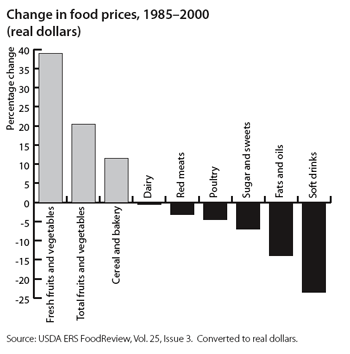I’m not much of a gourmand, but I do love to play with food. Well, food data, anyway. So when I happened upon the Food System Factoids blog, I totally pigged out. The menu may not be for everyone, but if you have a craving for analyses of food pricing trends, or evaluations of carbon emissions from US agriculture, you’ll find plenty to satisfy.
Take, for instance, this post on the relative change in prices of soft drinks and processed fats vs. fruits and veggies. The data’s a bit old now, but what a story. From 1985 to 2000, the real, inflation-adjusted cost of fresh fruits and veggies went up almost40 percent, while the costs of soft drinks went down by nearly a quarter.

So the incentives are pretty clear: given that median incomes didn’t rise that much over that period, and poverty rates remained constant, there were quite a few folks who pretty much had no choice but to trade apples for Coke. No wonder North Americans (including Cascadians) grew so much heavier over the period.




Jon Stahl
Wow. This is a powerful picture that tells a sad story.
MichelleV.P.
Great thought-provoking post, and which could perhaps germinate some additional food for thought, such as: Throughout the years, haven’t mass-manufactured “fizzy sugarwater drinks” always been cheaper than more labor-intensive and weather-dependent fresh fruits and veggies?And, during those aforementioned 15 years, since expensive organic produce had become increasingly more available on the supermarket scene, perhaps that could also account for the sky-rocketing price differences?
Arie v.
Unfortunately supermarket price trends do not reflect farmer costs and actual costs of food production. Produce prices don’t reflect oversupply unless you find an independent fruit and veggie stand. (Being Dutch-American and raised blue collar, we went through a lot of 10 cent a pound potatoes – hard to do today.)The poultry industry revolutionized in the 1990s and became much more efficient working now on mega-scales. Soft drinks I don’t get, maybe someone else can explain that one. Shipping water around never seemed that efficient to me, I always thought supermarkets would some day end up bottling their own with local H2O.
Dan
This topic was a Harper’s cover story a few years ago: “Let Them Eat Fat”, about having the lower incomes be sated by cheap calories. Folks need to be reminded of this constantly.
dbrook
Very interesting. My question is: why have the prices of (some) fresh stuff gone up and the processed stuff gone down?
Thriving on less driving
I learned in reading The Ominivore’s Dilemma by Micheal Pollan that the answer to why has the cost of processed food gone down is: corn! Foodstuffs with a falling price on the right side of the chart are all based on US government tax-payer subsidized hybrid corn. Farmers get paid by the government per acre of planted corn so, for certainty of income, they overplant. The result is an excess of corn. The cost goes down. What to do with all the corn? Feed it to cows (dairy, redmeat) even though they are grass-eating ruminants and require higher doses of antibiotics to stay healthy on a corn diet. Feed it to chickens. Reduce it into sweeteners. Make it into corn oil. Put it in soda (principal ingredient: high fructose corn syrup). Americans are eating the unhealthy result of their tax money. Micheal Pollan’s book, The Ominivore’s Dilemma, is a great read.